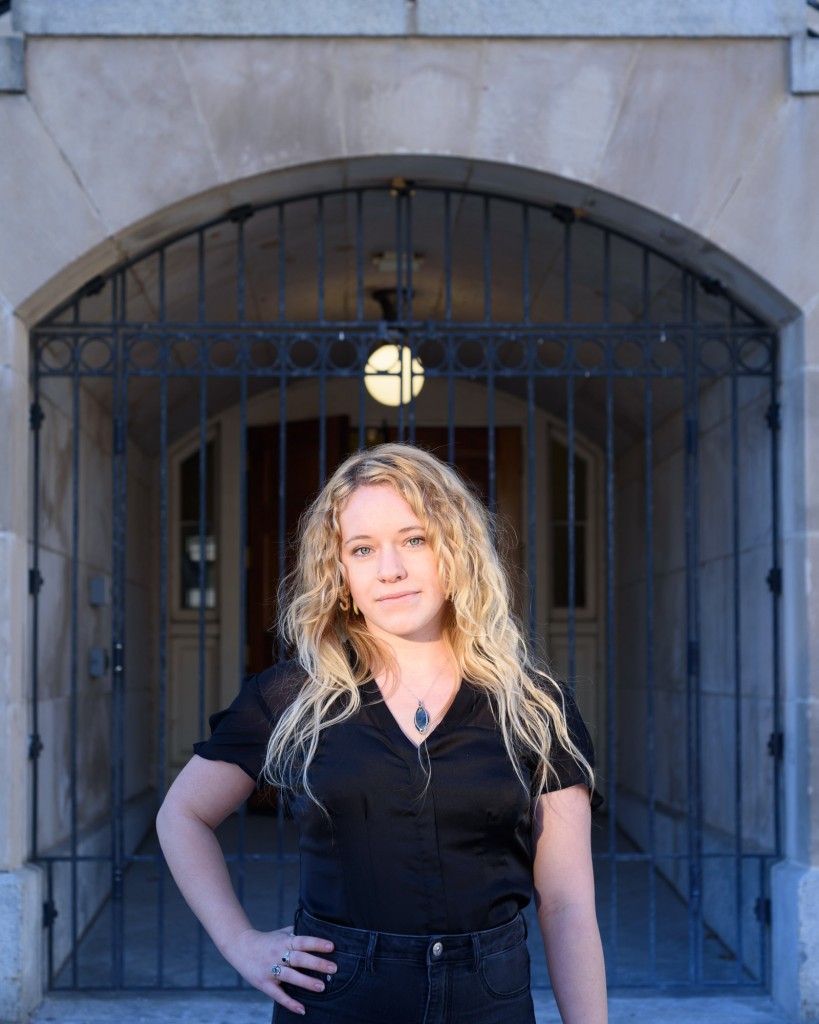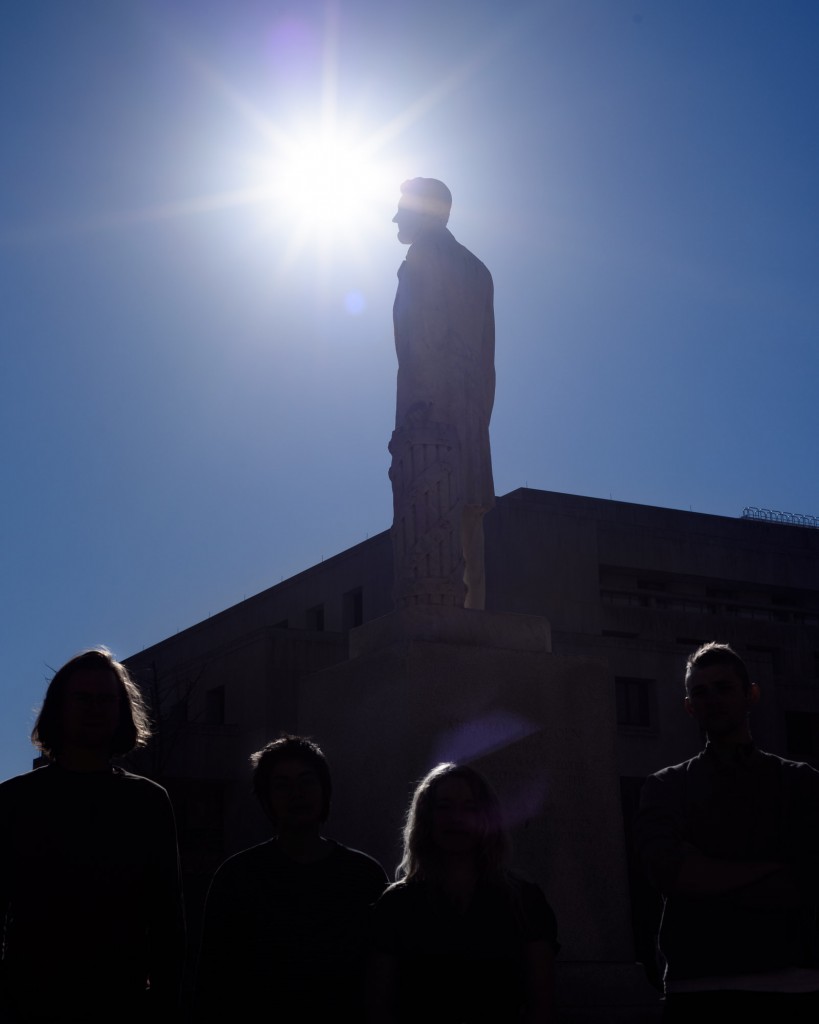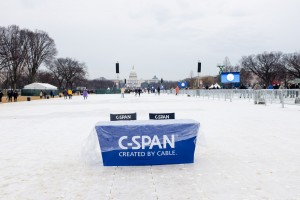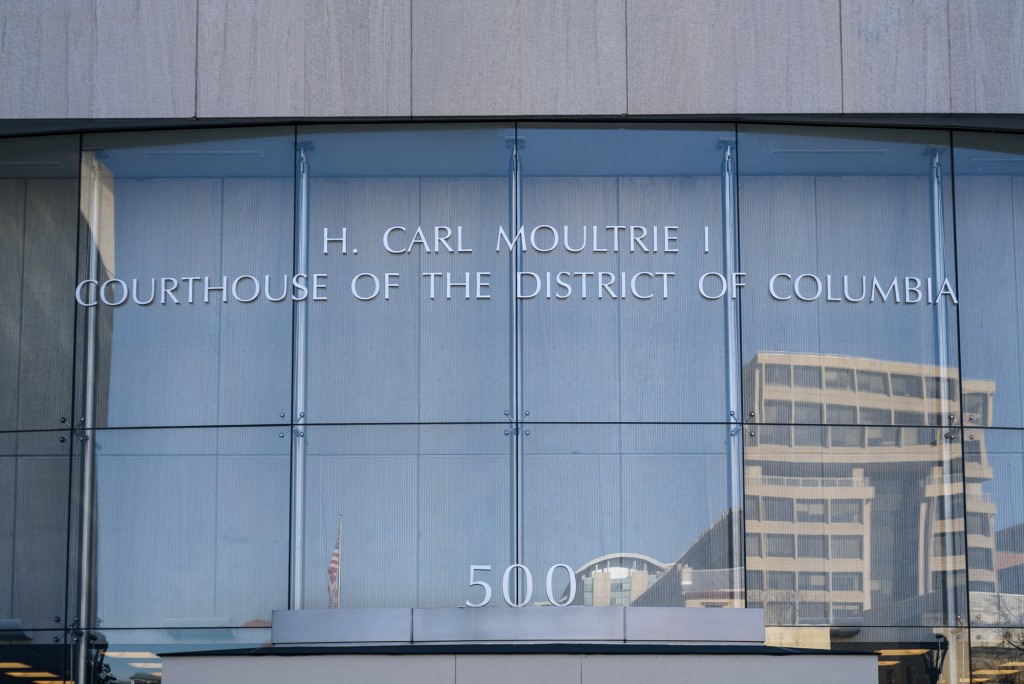
Elizabeth Lagesse was living in Baltimore in January 2017 as Donald Trump was about to be sworn in as the 45th President of the United States. She was looking for a job and, as she had done throughout her adult life, decided to join a protest march that had been in the works for months.
The 30-year-old from small town Northern California says she did not know any of the organizers of that march. A believer in “effective altruism,” Lagesse has always protested to express outrage and a desire to make the world a better place.
She grew up in a household of Creationists who identify as Trump supporters, and describes herself as “deeply nerdy.” Founder of the Chico Skeptics, a community science group of “secular humanists, non-theists and scientific thinkers,” Lagesse has given science presentations to school children, and a powerpoint presentation in a pub. “I believe in evidence, and facts,” says Lagesse, who until late last year was pursuing a Ph.D. in chemical engineering. “Bad science drives me nuts.”
Growing up going to anti-war protests in San Francisco, she says that riotous demonstrations have never unnerved her. “Personally I’ve never experienced bad stuff,” she says. “I’ve seen police use pepper spray, and I’m familiar with putting something over my face.”
On Inauguration Day, Lagesse and her partner drove from Baltimore to a Metro station near D.C. to attend a protest march organized by Disrupt J20, a loose coalition of anti-capitalist organizations opposed to Trump and his followers. “It was so empty,” she says of the in-bound Metro car. “We were like, ‘Really? There’s no one here.’” She wore a black-and-white T-shirt, a bright-colored inner jacket, and a long gray jacket. In her multi-colored bag, she carried protective gear: chem-lab safety goggles and a bandana. Left in the car were a couple homemade pink pussy hats for the Women’s March the next day.
Late to the protest, Lagesse caught up with several hundred protesters who were marching and chanting, according to a civil complaint she has since filed in U.S. District Court. Walking south on 13th Street N.W. toward Franklin Square, she encountered pepper spray, so she put on her safety goggles and covered her mouth with a bandana. As tension rose, she began to run along with fellow protesters, back up 14th Street, and east to 12th and L, where she was hemmed in by police cordons.
Lagesse had been “kettled,” the term for the police tactic of surrounding and confining crowds of demonstrators. She was about to be arrested, along with more than 200 others who participated that day in a Black Bloc, a group of protesters who wear black clothing and conceal their faces so that anonymous individuals can commit acts of vandalism without being identified. “I had been on the street for a short period of time,” she says. “I was like, ‘Dude, let me out.’”
Thirty-seven hours later, after the sting of pepper spray had subsided, and, allegedly, zip-ties had caused her wrists to bleed, she was released from custody. Lagesse alleges that she went hours without food, water or a bathroom, and that pepper spray caused her face to peel for weeks. She faces up to 61 years in prison, on charges of inciting a riot, rioting, conspiracy and destruction of property. She denies all charges.
One year later, a jury recently acquitted six co-defendants on similar charges, and prosecutors dismissed charges against 129 others. Yet Lagesse is one of 59 protesters yet to go to trial. She has suspended her job search, moved to D.C., and put plans of marriage to her fiancee—who also faces charges related to the protest—on hold. She spends her days attending court hearings, researching the law, supporting lawyers and co-defendants and pondering a future that is beyond her control.
A career shift could well be in order. “I’m pretty qualified, but there’s not much work here for a scientist-slash-felon,” she says with wry detachment. “This is hard. People came from all over for various reasons. There’s people like me that show up and don’t know everyone, or who didn’t plan to be part of a riot.”
 On a crisp, sunny day earlier this month, Olivia Alsip and a few fellow protesters are standing in the shadows of D.C. Superior Court, lamenting travel costs to and from D.C. She is upset that family and personal information is widely available, and that Alt-right Internet trolls harass and threaten her. “Even if I did re-locate to D.C., this has affected my life,” says Alsip, 24, a recent graduate of the University of Chicago’s master’s program in political science. “Psycho-socially, emotionally. People have had to quit their jobs, and some have gotten fired. This system wasn’t made to provide justice but to break people down.”
On a crisp, sunny day earlier this month, Olivia Alsip and a few fellow protesters are standing in the shadows of D.C. Superior Court, lamenting travel costs to and from D.C. She is upset that family and personal information is widely available, and that Alt-right Internet trolls harass and threaten her. “Even if I did re-locate to D.C., this has affected my life,” says Alsip, 24, a recent graduate of the University of Chicago’s master’s program in political science. “Psycho-socially, emotionally. People have had to quit their jobs, and some have gotten fired. This system wasn’t made to provide justice but to break people down.”
Like many, Alsip rejected a plea deal that would have yielded a misdemeanor rioting conviction but no jail time. “I refuse to help make it easier to crush a movement,” she says. Besides, she insists, she did nothing wrong. “I didn’t have any particular motives,” Alsip says, other than to resist Trump and an authoritarian “re-structuring of society.” Though anything “can go down” at a protest, she says, “it’s usually because the government is interested in criminalizing dissent, not in who broke windows.”
Alsip identifies as an Anarchist, as does Spencer Kaaz. The 22-year-old Kaaz is facing charges in D.C., but also pleaded guilty last year to disorderly conduct at the Iowa Air National Guard Base in Des Moines, where he protested the use of military drones in the Middle East. Days before the Disrupt J20 protest, he was among a small group of protesters arrested after chaining themselves to concrete-filled barrels outside a Valero refinery in his hometown of Memphis, in protest of an oil pipeline. Kaaz, who has dual German and American citizenship, says he came to D.C. on Inauguration Day expecting to be part of a Black Bloc. “It’s the reason I chose to be at an anti-Fascist, anti-capitalist march. The reason why windows [are targeted] is the businesses are symbols of capitalism, and it brings attention to worker exploitation, poor workplace conditions and low wages. These things go all the way back to the Boston Tea Party.”
 The dynamics of the Black Bloc pose a challenge for prosecutors: Proving the culpability of so many people, only a portion of whom committed acts of vandalism that day. There is no singular narrative that fits every defendant. Some were braced for violent confrontation, others simply wanted to protest Trump and all he stands for. One thing a dozen protesters interviewed for this story insist, is that the police reaction—pepper spray, concussion grenades, rubber bullets—outweighs whatever they or anyone else did that day. As Alsip says of the police, “Some pretty gross stuff happened.”
The dynamics of the Black Bloc pose a challenge for prosecutors: Proving the culpability of so many people, only a portion of whom committed acts of vandalism that day. There is no singular narrative that fits every defendant. Some were braced for violent confrontation, others simply wanted to protest Trump and all he stands for. One thing a dozen protesters interviewed for this story insist, is that the police reaction—pepper spray, concussion grenades, rubber bullets—outweighs whatever they or anyone else did that day. As Alsip says of the police, “Some pretty gross stuff happened.”
But if the Black Bloc functions as a vehicle for indiscriminate violence and destruction, why is it so surprising that punishment can land so indiscriminately on those who rolled with the Bloc in the first place? Key organizers and proponents of destruction haven’t even been charged, while those who protested peacefully face jail time. To Lagesse, the relative culpability among protesters and organizers is irrelevant. Their solidarity is unwavering. She and her fellow defendants are ready to face a jury, firm in the conviction that, “This is not an appropriate use of government power, from the police to the prosecution,” she says. “I reject the notion that those distinctions are the lesson we should take from this.”
***
Planning began well in advance of Inauguration Day. Undercover videos shot by a group called Project Veritas show Disrupt J20 meetings being led by Mike Isaacson, a John Jay College of Criminal Justice adjunct professor and co-founder of Smash Racism D.C., and Legba Carrefour, a D.C.-based Anarchist and veteran protester—neither of whom face criminal charges. (Project Veritas was founded by disgraced journalist James O’Keefe, who was in the news last year when an associate posed as a rape victim of Alabama Republican Roy Moore, a candidate for U.S. Senate, and offered it as a tip to a Washington Post reporter. Project Veritas’s methods are controversial, though one of its videos was introduced into the first Disrupt J20 trial.)
Group participation and coordination were essential to their mission, according to Carrefour and Isaacson as they are videotaped instructing would-be volunteers on how to to turn the Inauguration into a “clusterfuck.” “We do have a lot of ideas for plans and ultimately we just need people to be able to execute them,” Isaacson says in the video. “Simultaneous to the checkpoint blockades in the morning, we are also doing a series of clusterfuck blockades, where we are going to try and blockade all the major ingress points in the city,” adds Carrefour. “We don’t think these are necessarily going to be arrestable actions, but they could be, so keep that in mind if you want to participate.”
At one point, they talk about shutting down a Metro line. The idea, as far-fetched as it might seem, was to bolt a chain to a Metro car to keep it from moving. Isaacson also suggests that violence could be in order. “Generally speaking, Nazis will only actually attack people if they strongly outnumber them, because Nazis are essentially cowards,” he says. (In an email to District Dig, Isaacson says of the video, “In the interest of the almost 60 people still facing over 60 years in prison for 6 broken windows, I don’t think I should discuss that.”)
 Pre-protest bravado comes with the turf for veteran protesters and Anarchists. Carrefour is sipping a beer on the patio of Lyman’s Tavern one day last fall as he shares his worldview. The 37-year-old sports a full head of tussled black and gray hair, a three-day growth, punk rock t-shirt, khaki green jacket and heart-shaped sunglasses. Compared to Elizabeth Lagesse, he’s an O.G., going back to the World Trade Organization protests in Seattle in 1999, and the International Monetary Fund protest in New York City in 2001—his first mobilization as an Anarchist. “The heady years of the anti-global movement,” he says, showing off the scar above his eye from having his head slammed on the curb at the IMF protest. “Nothing brings people together like getting beat up by the cops.”
Pre-protest bravado comes with the turf for veteran protesters and Anarchists. Carrefour is sipping a beer on the patio of Lyman’s Tavern one day last fall as he shares his worldview. The 37-year-old sports a full head of tussled black and gray hair, a three-day growth, punk rock t-shirt, khaki green jacket and heart-shaped sunglasses. Compared to Elizabeth Lagesse, he’s an O.G., going back to the World Trade Organization protests in Seattle in 1999, and the International Monetary Fund protest in New York City in 2001—his first mobilization as an Anarchist. “The heady years of the anti-global movement,” he says, showing off the scar above his eye from having his head slammed on the curb at the IMF protest. “Nothing brings people together like getting beat up by the cops.”
Anarchists don’t believe in individual responsibility, Carrefour says. It’s a legal construct that doesn’t exist. They don’t believe in leaders, either, he says. Anarchy is about horizontal organization, mutual aid and solidarity, the most important virtue of all. Which makes organizing a bit tricky, because someone has to guide the discussion toward collective agreement. Carrefour clearly fits that description in the minds of law enforcers who have sought access to his Facebook contacts and communications. “Because of the conspiracy charge in the case, a lot of us who organized the mobilization are trying to avoid giving [the police] information that would be indicative of a conspiracy,” he says, by way of explaining his limitations on talking about Inauguration Day—including where he was that day.
Carrefour, who enjoys the techno music scene and occasionally bartends, also says Anarchism discourages elitism, which he associates with a brief stint as a dog walker for rich people who live in million dollar homes. “There’s a nanny, a housekeeper, me the dog walker, and someone at home playing on their Facebook page, while they pay people to clean their house, take care of their child, and walk their dog. And the only one who speaks English is [me] the dog walker.”
Such disdain flows easily into a crucible where views on the value of private property and the laws that protect it are forged. “I don’t think private property should exist,” Carrefour says. “There’s a lot of ways to adjudicate property but it’s important to recognize that no one has the answers.”
Therefore, property destruction has no intrinsic negative value, Carrefour says. “I’d say it has positive value. I’m pretty OK with property destruction.” One purpose is that it “raises the cost of doing business,” he continues, referring to the symbols of capitalism that typically sustain damage during riotous protests. “During the G-20 Summit protests the idea was to make it so expensive to hold summits that they would not want to have them. It’s also a way to ruin people’s good time.”
Not that breaking stuff was Disrupt J20’s only objective. A third organizer, Dylan Petrohilos, a 30-year-old activist, Anarchist and graphic designer with the Democracy Collaborative, appears in a separate Project Veritas video in which he talks to Disrupt J20 volunteers in a church basement in Northwest D.C. (The video, provided to The Dig by the U.S. Attorney’s Office, was introduced at trial.) “So, like, our goal is to continue to shut down the city by, you know, doing our thing,” Petrohilos says, referring to a “giant clusterfuck” intended to peak around the midway point of the Inauguration. “So, be prepared to help make the Inauguration a giant clusterfuck.”
In that same video, Petrohilos and Carrefour provide strategic instruction, assurance and advice that at times seem conflicting. For instance, Petrohilos tells volunteers: “In D.C., we do not have mass arrests. We don’t have kettles either. Those both have been banned.” But then he advises volunteers who are not arrested to seek safe haven from the police by dispersing into The Festival of Resistance, a separate protest. Still, he cautions, “The Festival of Resistance is supposed to be family-friendly, so don’t, like, break a window at The Festival of Resistance.”
Carrefour is less delicate. He says areas that are fully gentrified are “fair game,” and introduces a tactic known as jail solidarity, in which arrestees agree to refuse to give out their name or identification. “It jams up the jail system and they have to start releasing people,” he says. “We’ve seen it work at the Republican National Convention in St. Paul.”
A search warrant affidavit on file in D.C. Superior Court offers more insight into the Anarchist organizers of Disrupt J20. According to the warrant return, a March 2017 raid on Petrohilos’ Petworth home yielded a trove of electronic and communication devices that police alleged to be connected to the coordination of Black Bloc tactics on Inauguration Day. Among the computers, tablets, printers, fliers and flags, the return states, police recovered smoke bombs and M-80s. (Petrohilos later told TV news reporters the contraband was leftover from the Fourth of July.)
The affidavit also describes a podcast that went up on an Anarchist web site just days before the Inauguration. In it, an organizer known as “D” talks about “militant action,” including between 15 and 20 blockades, and an “anti-capitalist block” that would congregate at Logan Circle at 10 am on the big day. Along with a female podcaster known as “Mads,” “D” says that as a result of the lawsuits over the notorious Pershing Park protest arrests, D.C. Police had “been sued into a state of fear,” and as a result had become like “trained little piggies.” They tell listeners that the police do not use pepper spray. To bolster their claim, they refer to a pair of “rowdy protests” shortly after the presidential election during which law enforcers “did literally nothing.”
“I think we just outflanked them and they were scared,” says “D”, whom police identify in the affidavit as Petrohilos.
“Well, we are good at that,” says “Mads”. Then they laugh.
Given time to reflect, Petrohilos now says he has no regrets about the protest itself, but that it was “foolish” to not be better prepared for the worst-case scenario. “The D.C. left was unprepared for repression of activists,” he says, in a text message to The Dig. In a phone conversation, he adds that deployment of police use of force and kettling show that D.C. Police Chief Peter Newsham is looking to “reintroduce authoritarian tactics into the police lexicon.”
***
All it took was 33 minutes before the Disrupt J20 protest march came to a screeching halt. There had been no reports of major organized presence of Fascists, or Nazis. No major fights or violent human confrontations, except between protesters and the police, which resulted in numerous injuries yet just two civil rights lawsuits, one by Lagesse. (Two protesters alleged they were anally assaulted while in police custody. They later dropped their claims.) No Metro cars were disabled.
If the goal was to disrupt the Inauguration of Donald J. Trump as 45th President of the United States, it’d be hard to call this aspect of the protests a success. As comically under-attended as the Inauguration was, no one has made a credible claim that it was due to protesters “shutting down the city.”
Yet those 33 minutes have affected the lives not just of those who smashed windows, lit fires and vandalized private and public property, but those of Lagesse and others who, at this time, have not been accused of the property destruction at the heart of the government’s case.
At approximately 10:15 am, according to court documents, police observed the crowd embarking from Logan Circle down 13th Street wielding hammers, crowbars, baseball bats, metal and wooden poles, lighters, flares, firecrackers and other explosives. Most wore black so as to make themselves indistinguishable from one another, over different covered clothing intended to confuse the police in the event of an arrest. They covered their faces, wore goggles and hoodies, carried signs, and chanted in unison as they marched: “Fuck it up.” “Fuck Capitalism.” “Whose streets? Our streets!”
Within minutes they began pulling newspaper boxes and trashcans into the street, lighting some on fire; spray painting private and public property; shattering and cracking windows of businesses such as Au Bon Pain, a BP gas station, a Starbucks, a McDonalds, a Bank of America branch office, and Bobby Van’s restaurant. They smashed up a limousine parked near The Washington Post building and a hired SUV that had transported Larry King to the studio where he was working that day, according to a tweet by King himself. Protesters threw hard objects at police and National Guard, and law enforcers deployed pepper spray, projectiles and other devices that stunned and injured untold numbers of protesters. Some protesters, including some interviewed for this story, dispersed at the sign of trouble, or simply ran back the way they’d come, or down alleys to escape.
A key piece of evidence introduced at the first trial is a live-streamed video shot by a self-styled photojournalist from San Antonio named Alexei Wood. In the video, Wood marches from Logan Circle along with the protesters and narrates the action, at times hooting and hollering in excitement. “Howdy folks, well, three blocks in, looks like we got ourselves a Black Bloc,” says Wood, grinning into the camera, wearing a bike helmet and goggles pushed up onto his forehead.
Wood revels in the building tension. “It’s go time,” he says, at about the seven minute mark, as a protester with a black ski mask takes a rock or brick to a parking meter. “Wooooo!”
As the action speeds up, he narrates a man he sees pushing a protester and begins shouting at the man. “You’re getting pretty aggressive there buddy.” The man says something back and Wood berates him: “Fuck off. Fuck off. Fuck you!” he says, over and over. “Woooooo!” he shouts, as protesters drag newspaper boxes into the street.
Wood quickens his pace to keep up. “Holy motherfucking shit, y’all. Woooo!” he shouts, as protesters descend on the limousine and smash the windows with rocks and chunks of concrete. He turns the camera on himself again with an exhilarated, satisfied look on his face. “Couple motorcycle cops, oh, we got National Guard here y’all,” he says, entering Franklin Square. Then, back out on the street, he observes some prime destruction: “We got Bank of America, that there is happening,” he says, as protesters shatter glass windows. In the background, protesters can be heard shouting “Fuck America,” “Fuck the police,” and “Fuck you pigs,” as cops line their bicycles along the march route. “Woooo!” Woods shouts, strapping on his gas mask, police sirens blaring in the background.
As police ramp up the use of pepper spray and concussion grenades, protesters begin dispersing. Wood keeps filming. “I mean, this is it, y’all, this is the fucking Seattle 1999 that I missed, and I vowed I’d never ever ever fucking miss it again. Well, I got it. I’m fucking blissed out…Oh, and we got lazy ass National Guard trying to get geared up, putting on their gas masks, trying to look cool y’all, but they’re sweatennn.”
He mocks a National Guardsman who takes a rock to the groin.
By approximately 10:52 am, police and riot squad have the group surrounded on three sides up against a building at 12th and L Street. More chaos and confusion ensues. Wood’s video, introduced as evidence at trial, shows a group of Black Bloc protesters banding together, counting down, and charging police officers lined up on 12th Street in an effort to break through the police line, causing several officers to fall off their bikes and sustain injuries. Though some break through, many of the charging protesters are repelled by a persistent stream of pepper spray until they relent.
If the Disrupt J20 protest turned into a clusterfuck, the criminal case in D.C. Superior Court is its courtroom cousin. Before the first trial could get under way, Chief Judge Robert Morin trudged through preliminary motions related to which private and social media communications the prosecution was entitled to. “We’re in a new world,” he says at an October hearing, in which lawyers for Facebook resist over-reach by the prosecution. “There has to be a limit to how much of a fine tooth comb [is permissible]. We don’t want to have a chilling effect on the right to organize or the right to free speech.”
Superior Court Judge Lynn Leibovitz, presiding judge of the Criminal Division, dealt for months with motions to dismiss charges, motions to sever individual defendants from their multi-defendant groups, discovery rulings and due process, before structuring a series of trials that could run through 2018.
From the first day of trial, Assistant U.S. Attorney Jennifer Kerkhoff made clear that the first six protesters to face trial did not take part in actual destruction of public or private property, nor did they assault police officers. Lagesse, who talked with two jurors after the jury acquitted the first six defendants of all charges, thinks the government lost its case on that first day. Indeed, Judge Leibovitz’s instructions to the jury were to decide guilt or innocence based on “willful intent” to engage in a riot. “I don’t engage in property destruction, and I haven’t given a lot of thought to the philosophy behind that,” she says one day last week, sitting on a park bench across the street from where she was arrested. “A lot of this is arbitrary. The charging decisions are unexplained. Why are my partner and I two of the remaining 59 defendants?”
She suspects she is among those targeted because she has been outspoken with the media, or because of her civil lawsuit against D.C. Police, brought by the ACLU. Lagesse’s civil complaint states that police initiated the violence by releasing pepper spray, smoke flares, concussion grenades, flash bang grenades and “stingers,” which spread smoke, rubber pellets and a chemical spray within a 50 foot radius, and that they injured her wrists and deprived her of her civil rights by holding her for more than 30 hours—much of it without access to water or a bathroom. All because she wore dark clothing and was protesting amid the Black Bloc, she says. “Color coordination is not a conspiracy,” read her Facebook profile for a time.
There is support for her contention that the police over-reacted if not crossed a more serious line. A February 2017 report by the Police Complaints Board to Mayor Muriel Bowser, the D.C. Council and Chief Newsham sites numerous observations by protest monitors that “raise concerns about how protests were handled.” Lagesse points out that use of pepper spray and other deterrents without adequate warning constitutes a violation of a General Order that prohibits such measures absent legal cause to take someone into custody. D.C. Bar Association monitors also reported that a majority of the protesters that day were just protesting peacefully. The report prompted an outside review by The Police Foundation, a national non-profit, non-partisan, and independent research and investigation agency.
Alexei Wood, who was among those acquitted, was not as worthy of righteous indignation, according to the judge, who lambasted him for his conduct in his live-streamed video. Wood had showed up for the first day of court with a swagger, but by the end of the trial, as the jury heard final arguments, his head was down, and he looked shook up.
But Lagesse has nothing but support for Wood. “His excitement was clearly related to getting the story,” she says. “There’s nothing wrong with enjoying your craft.” Likewise, her solidarity extends to all of her fellow defendants—and even those organizers who have steered clear of harm’s way. “The coalition had dozens of events and protests that day,” she says. “I don’t have hard feelings over [organizers] that didn’t come to the one I was at. And I’m happy for anyone who doesn’t have to put up with this crap.”
And although she ran that day with the Black Bloc, she also holds tight to her individualism. “I agree with some things Libertarians think, or Socialists, or regular old Democrats. It depends on what the issue is. Regardless of how you feel about the protesters, this whole thing has been more punishment than is warranted even if all the charges were dropped tomorrow.”
Yet Lagesse does not rule out future protests. “It’s not like I regret a lifetime of attending protests because something stupid happened and I might go to prison,” she says. “But realistically, I’ll be thinking about how disruptive this has been, and asking do I want to go through this again. Which is the problem, isn’t it? The government’s action has taken people out of the game. It intimidates potential protesters with the prospect of going to jail for something they didn’t do.”
Meantime, she has become consumed with the law. She has no intention of taking a plea deal or dropping her civil case. The job search remains on hold, as do marriage plans. The thought of law school is intriguing. Defense lawyers on the case have already offered to write her letters of recommendation. “I’m coming around to the idea that criminal justice reform is where it’s at,” she says. “Who knows, maybe I’ll be on 60 Minutes in five years after arguing before the Supreme Court.”
Photographs by Andy DelGiudice. Portrait of Legba Carrefour by Jeffrey Anderson.


